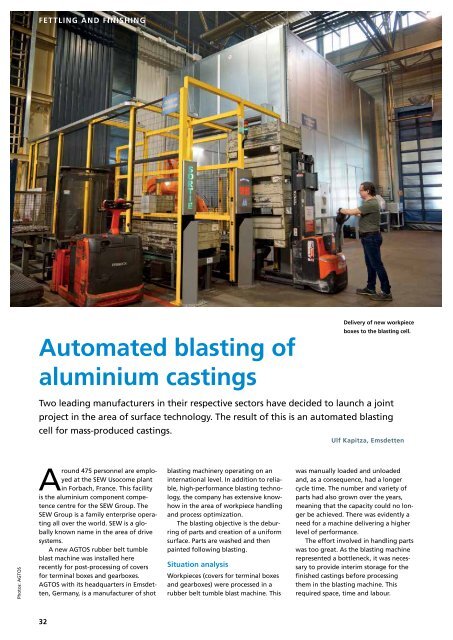CPT International 4/2019
Create successful ePaper yourself
Turn your PDF publications into a flip-book with our unique Google optimized e-Paper software.
FETTLING AND FINISHING<br />
Automated blasting of<br />
aluminium castings<br />
Delivery of new workpiece<br />
boxes to the blasting cell.<br />
Two leading manufacturers in their respective sectors have decided to launch a joint<br />
project in the area of surface technology. The result of this is an automated blasting<br />
cell for mass-produced castings.<br />
Ulf Kapitza, Emsdetten<br />
Photos: AGTOS<br />
Around 475 personnel are employed<br />
at the SEW Usocome plant<br />
in Forbach, France. This facility<br />
is the aluminium component competence<br />
centre for the SEW Group. The<br />
SEW Group is a family enterprise operating<br />
all over the world. SEW is a globally<br />
known name in the area of drive<br />
systems.<br />
A new AGTOS rubber belt tumble<br />
blast machine was installed here<br />
recently for post-processing of covers<br />
for terminal boxes and gearboxes.<br />
AGTOS with its headquarters in Emsdetten,<br />
Germany, is a manufacturer of shot<br />
blasting machinery operating on an<br />
international level. In addition to reliable,<br />
high-performance blasting technology,<br />
the company has extensive knowhow<br />
in the area of workpiece handling<br />
and process optimization.<br />
The blasting objective is the deburring<br />
of parts and creation of a uniform<br />
surface. Parts are washed and then<br />
painted following blasting.<br />
Situation analysis<br />
Workpieces (covers for terminal boxes<br />
and gearboxes) were processed in a<br />
rubber belt tumble blast machine. This<br />
was manually loaded and unloaded<br />
and, as a consequence, had a longer<br />
cycle time. The number and variety of<br />
parts had also grown over the years,<br />
meaning that the capacity could no longer<br />
be achieved. There was evidently a<br />
need for a machine delivering a higher<br />
level of performance.<br />
The effort involved in handling parts<br />
was too great. As the blasting machine<br />
represented a bottleneck, it was necessary<br />
to provide interim storage for the<br />
finished castings before processing<br />
them in the blasting machine. This<br />
required space, time and labour.<br />
32

















